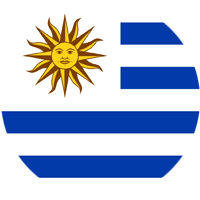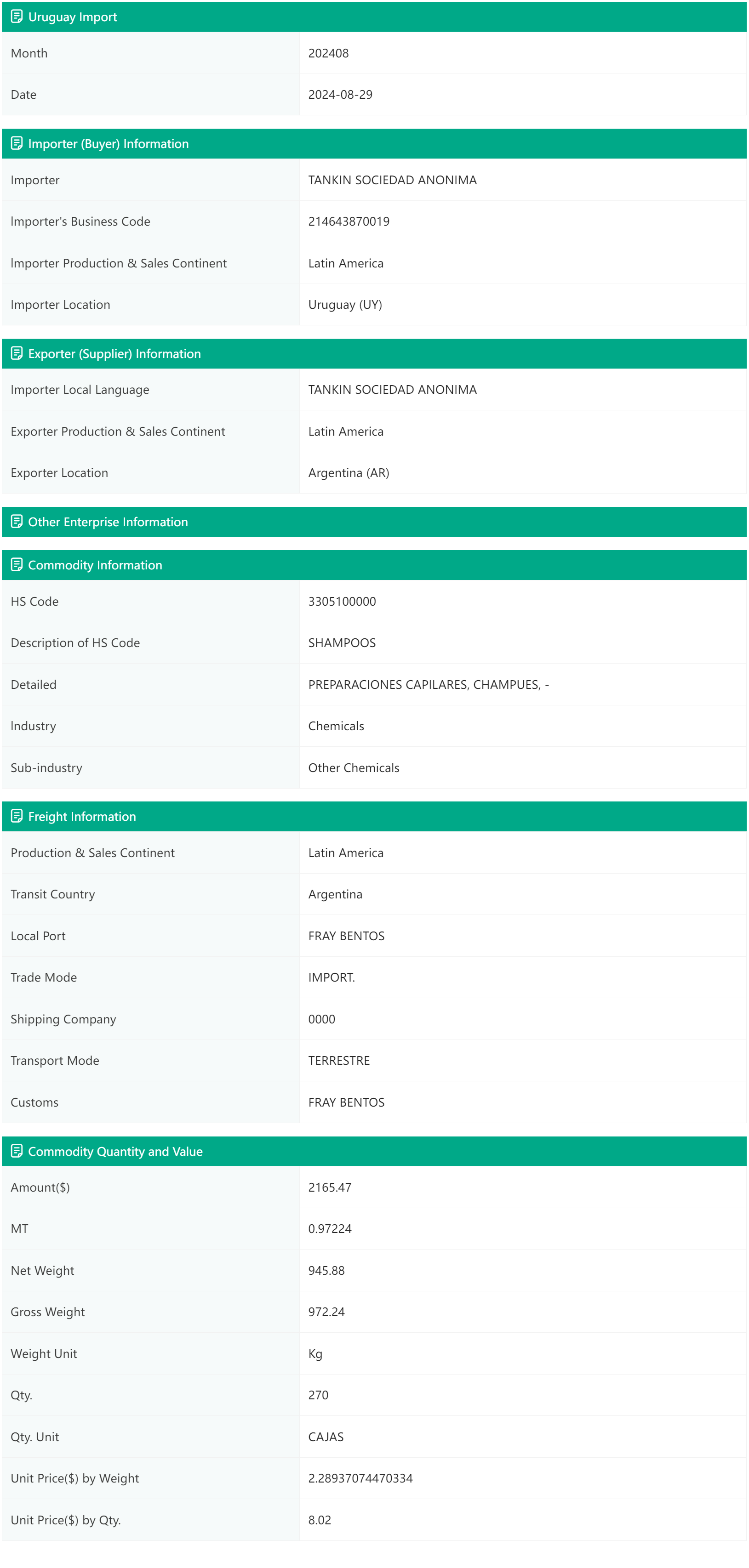Please Sign in to view recently saved searches.
**Oriental Republic of Uruguay**
Located in the southeastern part of South America, Uruguay is bordered by Brazil to the north, the Atlantic Ocean to the southeast, and is separated from Argentina by the Uruguay River and the lower Río de la Plata to the west. Uruguay, along with Brazil, Argentina, and Paraguay, is a member of the Southern Common Market (Mercosur). The country follows an open trade policy and is one of the most open economies in South America.
**Official Language**
Spanish is the official language of Uruguay. English and French are traditionally taught as foreign languages, with English being widely used in business interactions. In recent years, the status of Portuguese has also risen.
**Customs**
From mid-December to mid-March, Uruguayans typically take vacations, and it is recommended to avoid business trips during this period. When meeting with foreign guests, even for the first time, Uruguayans usually greet warmly with a handshake and exchange pleasantries. Common terms of address include "Mr." and "Mrs." For unmarried youth, "young man" and "miss" are used. Uruguayans also appreciate being addressed by their professional or academic titles, such as "Mr. President" or "Dr." When attending a banquet, guests typically bring gifts like cake or wine. Men are expected to allow women to enter or exit doors first, and in formal dinners, it is customary to serve women first. Socially, Uruguayans may shake hands when greeting or parting from guests and close friends may hug. For first-time meetings, people often say "mucho gusto" (pleased to meet you), and conversations are held at close distance. Men commonly embrace upon greeting, while women kiss each other on both cheeks. Close friends may walk arm in arm. When visiting someone's home, it is polite to begin with a short speech of greeting before requesting to enter the home. Suitable conversation topics include family, sports, current events, and weather, as well as football, which Uruguayans are proud of. Avoid discussing politics. Similar to many Western countries, Uruguayans avoid the number 13 and Fridays and consider the color blue to be associated with bad luck.
**Agriculture, Livestock, and Fisheries**
Agriculture plays a key role in Uruguay’s economy, with most agricultural and livestock products being exported. In 2020, agriculture, livestock, and fishing contributed 8% to the national economic output. Key exports include beef (USD 1.58 billion), pulp (USD 1.1 billion), soybeans (USD 750 million), and dairy products (USD 650 million). Uruguay is rich in forestry and fishing resources, with large catches of yellow croaker, squid, and cod. Forestry contributes about 3% to Uruguay’s GDP, with wood, paper, and pulp making up 20% of exports. Around 1,700 companies are directly involved in this sector.
**Manufacturing**
Uruguayan manufacturing is primarily focused on processing agricultural and livestock products, including meat processing, oil extraction, winemaking, sugar refining, and canned food, flour, dairy, and cheese processing. Other key industries include wood and paper processing.
**Multilateral Trade Agreements**
Uruguay is a member of the World Trade Organization (WTO) and has signed bilateral investment and tax agreements with countries like Germany, Australia, Canada, South Korea, Spain, and India.
**Regional Trade Agreements**
In 1991, Uruguay, Argentina, Brazil, and Paraguay signed the agreement establishing Mercosur, aiming to gradually eliminate tariffs between member countries and unify tariffs on imports from non-member countries, which range from 0% to 20%. Uruguay's average tariff rate on non-Mercosur countries is 12.5%, though higher tariffs are applied to non-essential goods and special products like dairy, leather, clothing, wool, certain plastics, and automobiles, reaching up to 21.5%. Uruguay has free trade agreements with Mexico and Chile.
**Geographical Reach**
Uruguay's strategic location, excellent port facilities, and favorable policies in free trade zones have attracted numerous foreign companies to use Uruguay as a platform for trade, investment, and logistics, promoting the country's foreign trade. In addition to significant trade with the U.S., China, and European countries like Germany, the U.K., and Spain, Uruguay's geographic influence extends to markets like Argentina, Brazil, Chile, Paraguay, and Bolivia.
**Foreign Trade - Exports**
In September 2024, export requests, including those from free trade zones, reached USD 1.182 billion, up 14% year-on-year, marking the sixth consecutive month of export growth. This increase was mainly driven by soybean and pulp exports, while meat exports had a slight negative impact on the overall total. Year-to-date, exports amounted to USD 9.732 billion, up 15%.
**Key Export Products**
1) **Pulp** maintained its top position in Uruguay’s exports, with sales of USD 260 million in September 2024, a 36% increase from September 2023. The EU was the main destination, accounting for 54% of total exports, while China’s share grew, reaching 39%. Other destinations included the U.S. and Argentina, accounting for 3% and 2%, respectively.
2) **Soybeans** ranked second with exports totaling USD 164 million, an 89% year-on-year increase. Export volumes rose by 125% to 397,835 tons. China was the largest destination, absorbing 70% of exports, followed by Argentina, which saw its imports from Uruguay increase by 242%.
3) **Beef** exports amounted to USD 162 million, down only 1% from September 2023, primarily due to reduced exports to China, which dropped by 43%. However, U.S. beef exports surged by 91%, making the U.S. the top destination for Uruguayan beef, accounting for 33% of the total. Other key markets included the EU (16%) and Israel (9%).
**Major Trading Partners**
1) **China** was Uruguay's top export destination in September 2024, with sales totaling USD 299 million (25% of total exports), a 45% increase year-on-year. This was driven by soybean exports valued at USD 113 million (38% of total exports). Pulp was the second-largest export to China, growing by 16% year-on-year to USD 102 million. Beef exports to China decreased by 43%, totaling USD 44 million.
2) The **EU** was Uruguay's second-largest export destination, with sales of USD 196 million, a 51% year-on-year increase. Pulp dominated exports to the EU, followed by beef and rice.
3) **Brazil** ranked third, with exports worth USD 178 million (15% of total exports). Despite a drop in car exports, plastics and beverage concentrates showed significant growth.
4) **Argentina** moved up to fourth place, with total sales of USD 100 million, a 66% year-on-year increase, largely driven by soybean exports.
5) **The U.S.** ranked fifth, with exports totaling USD 85 million, largely led by beef exports.
**Blooming Trade Data**
Uruguayan customs data is updated regularly with reliable sources. Detailed trade data includes information on importers, exporters, goods, shipments, as well as key volume and price data, helping you stay informed of the latest trends in Uruguay's import and export markets.
Are you looking to understand market demand in Uruguay? Do you want to expand your international presence there? Are you seeking stronger partnerships with clients and reliable suppliers in Uruguay?

Sample Data


Would you like to stay informed about your competitors' activities in the Uruguayan market?
